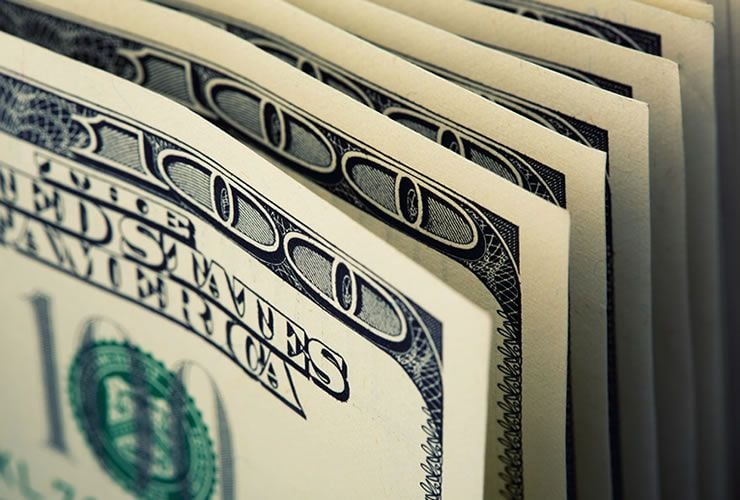US Dollar Gamechanger to be Found in Potential Trump-Democrat Fiscal Alliance
- Written by: James Skinner

Markets could be underestimating the impact on the Dollar of a deal on tax and spending reforms between the White House and Democrats.
The US Dollar could find support over coming months as expectations of a possible deal on US tax cuts mount.
Possible tax reform is now back firmly on the agenda suggest strategists at Morgan Stanley after a recent step across the aisle by President Donald Trump led to him striking a temporary deal on the debt ceiling directly with Democrat leaders.
"Against this background a US tax reform with the backing of the Democrats containing infrastructure programs and corporate tax cuts seems increasingly possible," says Hans Redeker, a London based strategist with Morgan Stanley.
The move opens up new possibilities in the minds of traders who had all but given up on hopes of tax reforms coming from Washington in the near future, after infighting among Republicans led to a string of legislative setbacks for the President earlier in the year.
Recall it was the promise of lower taxes and increases on infrastructure spending that propelled the Dollar higher when Trump won the November vote.
The decline in the Dollar through 2017 has occured as it Trump's ability to deliver on his promises were thwarted by Congress - a Congress that his party commands.
In particular, the Republican's House Freedom Caucus coming out against higher deficits and debt levels which has been making it difficult to find a majority for a tax and budget package within the Republican Party.
Any move towards finally delivering on tax cuts and infrastructure spending increases could trigger renewed gains for the Dollar over currencies like the Pound, Euro, Japanese Yen and Swiss Franc.
Cash Rich And Coming Home: Not Priced In
“Markets may under-price such an outcome especially in respect of its funding. The Democrats and the President may easily agree to ‘monetise’ the USD3trn of accumulated US foreign profits, i.e increasing the incentive to bring these offshore funds back home into the US,” says Redeker.
Deadlock and dysfunction were key drivers behind the sharp fall in the US Dollar during recent quarters, leading to downgraded growth expectations and downward revisions to market forecasts for the Federal Funds rate.
“Currently, repatriation of offshore US funds attracts a 35% tax rate. Taking the repatriation tax rate below the average 20% OECD corporate tax rate should push US tax revenues temporarily higher, helping to fund the tax reform,” Redeker adds.
Get up to 5% more foreign exchange by using a specialist provider by getting closer to the real market rate and avoid the gaping spreads charged by your bank for international payments. Learn more here.
Dollar Support: Yields to Move Higher Amid Bond Sell Off
The most cash-rich corporates in America are estimated to have more than $1 trillion in offshore deposits, according to Morgan Stanley, a symptom of the US have among the highest corporate tax rates in the world.
“Should tax reform talks between the White House and the Democrats gain momentum US bond yields, including the corporate bond spreads, may be carefully watched by market participants,” says Redeker.
Much of America Inc’s offshore cash balance is invested in US Dollar denominated securities such as corporate bonds.
“Tax reform may lead to a wave of corporate bond selling... Higher yields would support the USD vs low yielding currencies,” Redeker predicts.
Underestimating The Rate Path Too?
The Dollar story is of course more than just Trump politics; the Federal Reserve matters too.
Markets may also be underestimating the likely path of the Federal Fund rate, according to a report from Bank of America Merrill Lynch.
BofA strategists have argued the Fed will likely leave its inflation forecasts largely unchanged at its September 20 meeting, paving the way for another increase of the Federal Funds rate before year-end.
The Dollar has struggled as markets discount such a rate rise occuring against in 2017.
"For the first time the Dot Plot has been right this year and markets have been wrong, and we believe that this remains the case," says Athanasios Vamvakidis, a BofA strategist. "The Fed has been hiking and keeping the Dot Plot the same despite low inflation this year, focusing on loosening financial conditions instead."
Vamvakidis advocates buying any dips in the US Dollar and has forecast the Euro-to-Dollar rate, which has risen by 14% for the year to date, to fall back toward the 1.1500 level before year-end.
Interbank Order Flows Support A Stronger Dollar
Bank of America also note interbank order flows are an accurate leading indicator of currency returns for 19 out of 23 G10 and emerging market currencies the bank tracked for its report.
“Looking at the partial data for September (1-8 September), there is broad evidence of USD demand that has yet to translate to meaningful currency gains,” says Vadim Iaralov, a strategist at BAML.
The early September increase in net demand for the Dollar on the interbank market suggests the greenback could see a further bounce before the month is out.
“Our analysis suggests spot playing catch up for GBP/USD, EUR/USD, for USD/CAD and for USD/RUB by the end of September when we compare the expected return vs actual return (1-8 September),” writes Iaralov.
It is suggested the Pound-to-Dollar rate could gain more than 2% before the month is out while there may be as much as 2.4% upside in the price of USD/CAD.




